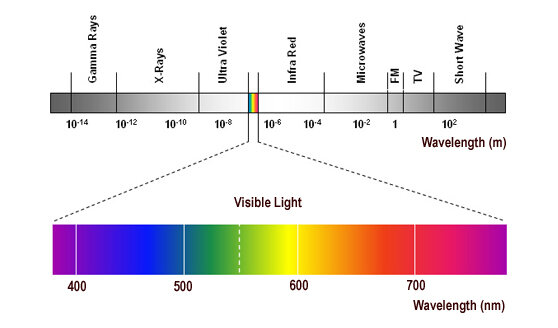WHAT IS LASER?
Electromagnetic radiation is a natural phenomenon found in almost all areas of daily life, from radio waves to sunlight to x-rays. Laser radiation – like all light – is also a form of electromagnetic radiation.
The laser is the most advanced of our light sources. The first working laser, a ruby laser, was demonstrated by Theodor Maiman at a press conference in Los Angeles on 7 July 1960. The word LASER is an acronym from Light Amplification by Stimulated Emission of Radiation. A laser is therefore a type of light amplifier. Lasers are often named after the substance that are included in the light amplifying media.
A laser is a source of light that emits extremely pure light. Pure light means light that only has a single wavelength, not an entire spectrum. It can be likened to the “purer” sound of a flute in comparison to the sound of a tin of stones being rattled. The flute emits sound of a certain fixed tone (wavelength). Just like the flute, a laser also emits long connected waves. The light from a laser is very tidy and well-organised, while light from lamps is completely disorganised. In specialised terminology laser light is described as coherent.
The pure, coherent sound of a flute can affect both us and matter in a different way than the impure sounds of thundering traffic. A pure tone of the correct frequency can make a crystal glass self-oscillate (resonate) and can even make glass shatter. In the same way, coherent light can affect our cells in a different way to that of incoherent light. There are hundreds of different types of lasers. They can be made strong or weak. Most of them are weak. The light can be any colour at all, or it can be invisible. The beam can be narrow or wide, parallel, or divergent.
WHAT ARE MEDICAL LASER?
There are many different types of lasers with medical uses. Some lasers can measure blood flow and be used in diagnostics. The lasers used in treatments can be divided into two main groups:
1. Strong lasers: which can be used for cutting, coagulating, or burning away tissue. These lasers are often called surgical lasers because they can replace a surgeon´s scalpel. The action principle here is burning glass effect – when strong light is absorbed, light energy is converted to heat energy.
2. Weak lasers, which can be used for stimulating cell functions. These are often called biostimulating lasers, phototherapy, photobiomodulation, laser therapy or low-level lasers (LLLT). Their biological effect is not based on heat development, like surgical laser; instead, the pure light from the laser produces photochemical reaction in the cells. Sunlight or lamp light does not give the same effect in tissue.
HOW DOES LASER THERAPY WORK?
It involves very complicated processes in the cells and tissues, but, in brief, you can say that laser therapy affects the local immune system, blood and lymph circulation, cell metabolism and the release of different substances, e.g. endorphins and prostaglandins, which influence the perception of pain, amongst other functions. There is not always a stimulating effect: laser phototherapy can have a normalising effects. However, when done correctly, laser therapy can initiate healing processes and is therefore primarily an aid to self-help.
WHAT CAN BE TREATED WITH LASER THERAPY?
Different types of lasers affect cells and tissue in different ways. What can be treated is there for dependent on the type(s) of laser that the therapist has available.
The medical effects of laser light, as observed by Endre Mester and many others after him, are often called biostimulating effects. However, in order to achieve good results, three things are required:
A skilled therapist
A good laser instrument with the right wavelength
A correct diagnosis
LASER TYPE, POWER OUTPUT & WAVELENGTH
The strength - or more correctly, power output - of a laser, is primarily significant for the length of the treatment. A certain set dose is achieved more quickly with a stronger laser than with a weak one. The power output is not decisive in obtaining good results, but with a stronger laser you often get a higher power density which can be of importance. Power density means the light’s output power per surface unit, and different instruments have different power densities. Biostimulation is based upon affecting cells; power density that is too low or too high has a reduces biological effect.
The lasers that are most common within laser therapy are:
Indium Gallium Aluminum Phosphide laser (HeNe & InGaA1P)
They emit visible red light with the wavelength interval 633-670 nm and are most effective for problems with skin and mucus membranes.
Gallium Aluminum Arsenide laser (GaA1As)
This semiconductor laser can be produced with a wavelength almost anywhere in the infrared region from 780nm and up to about 1400 nm. its wavelength is most commonly between 805 and 830 nm. This laser usually works continuously, but can be pulsed and has a penetration depth of 2-3cm. It is best on tendons, but is also good for bedsores, herpes and dental use.
Gallium Arsenide laser (GaAs)
This laser emits infrared radiation with a wavelength of 904nm. It is always pulsed, with extremely short pulses of high intensity, more or less like flash bulb. Because of its high peak power, its penetration is considerably greater than for a laser of the same wavelength but which is not super-pulsed. Measurements show that penetration depth is as deep as 3-5cm, depending on tissue type and working method. This laser is best for deep seated problems in the back, neck, shoulders and knees, tendonitis, arthritis, and myofascial pain.

